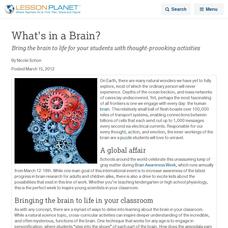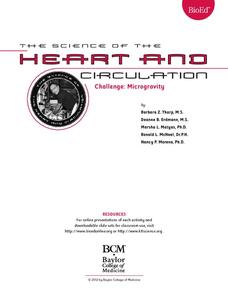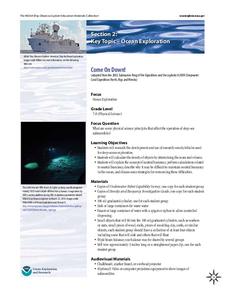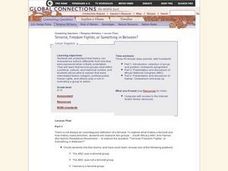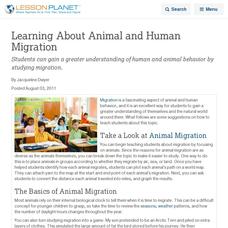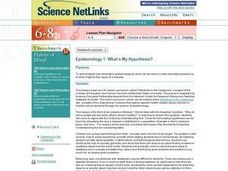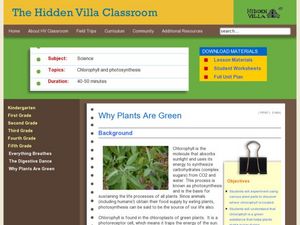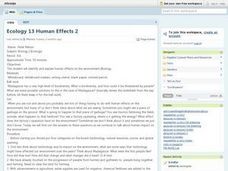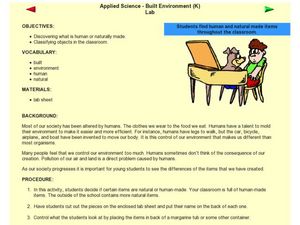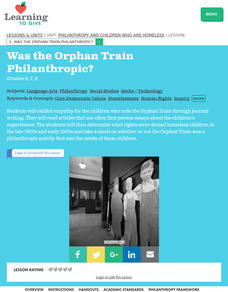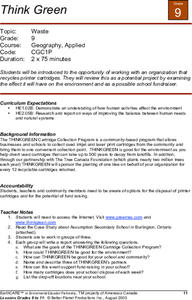Curated OER
What's in a Brain?
Bring the brain to life for your students with thought-provoking activities
Curated OER
The Chesapeake Bay in Captain John Smith's Time
When Captain John Smith visited the Chesapeake Bay in the summer of 1608, what types of animals and habitats did he encounter? Your young historians will analyze primary source documents to answer this question, as well as compare...
King Country
Lesson 7: Relationships - Day 5: Acquaintances & Strangers
What is the difference between a friend and an acquaintance? What about an acquaintance and a stranger? As part of a unit on Family Life and Sexual Health (FLASH), class members role play appropriate responses to situations involving...
Curated OER
Celebrate Martin Luther King Jr. Day in the Most Meaningful Way
Lead your class on a journey into the Deep South so that they understand the true meaning of what inspired this holiday.
Baylor College
Challenge: Microgravity
What a festive way to examine what happens to the heart in different gravitational situations! Small groups place a water-filled balloon in different locations (on a table top, in a tub of water, and held in a vertical position), drawing...
NOAA
Come on Down!
What do we do when a dive is too dangerous for humans to accomplish? Send in the robots! Middle school scientists get acquainted with several different models of submersible robots in the second lesson plan of six from NOAA. Lab groups...
Curated OER
Teaching the Written Word to Those Whose Words are Limited
Get your learners' pens moving by emptying their thoughts onto the page.
Curated OER
Civil Rights in America
Seventh graders visit the Smithsonian and are shown different exhibits. They are to make their own drawing about one of the exhibits and write about the experience.
Curated OER
Circulatory Systems
Excellent diagrams, labels and summaries make this resource be valuable to your students throughout the topic of circulation. All types of circulation vessels are explained, their structure and function is detailed, and the overall...
Curated OER
Extending Human Ability Through Technology
Learners explore how technology has been used to enhance human abilities. Using the internet, they watch a short video about prosthetics. They compare and contrast how prosthetics have changed over the years as technology has become...
Curated OER
Humane Science Projects
In this science worksheet, middle schoolers examine the list of possible science projects. They look for the characteristics that set apart these ideas as humane.
Curated OER
Dissidents Delicately Democratize
Students read and discuss the article, 'Chinese Dissidents Issue a Sharp Challenge to the Government' on pro-democratic manifestos that were recently written in China, write a journal entry on what human rights means to them.
Curated OER
Cracking the Genetic Code
Students examine an article, "Genome 'Treasure Trove'" and participate in a class discussion prior to researching further information in order to write their own feature article on the Human Genome Project.
Curated OER
Terrorist, Freedom Fighter, or Something in Between?
Students identify that history can characterize actions differently from how they were perceived when initially undertaken. Then they identify that terrorist groups exist within a political, cultural, and historical context, and students...
Curated OER
Learning About Animal and Human Migration
Students can gain a greater understanding of human and animal behavior by studying migration.
Curated OER
What's All the Buzz About
Students participate in a game of charades to examine different animal behaviors. After reading an article, they discuss why bees waggle and how that behavior applies to humans. They research the behaviors of an animal of interest to...
Curated OER
Epidemiology 1: What's My Hypothesis?
Students demonstrate how descriptive epidemiological clues can be used to make educated guesses as to what might be the cause of a disease.
Curated OER
Why Plants Are Green
Students discover the properties of chlorophyll in plants. In this plant biology lesson, students conduct an experiment to find where the chlorophyll in the plant is located. Students are split into small groups and study plant parts....
Curated OER
Ecology 13 Human Effects 2
Students identify and explain human effects on the environment. They explore the terms biodiversity, natural resources, ozone and global warming. After exploring all the terms , they connect technology to them and how it effects the...
Curated OER
Understanding Human Rights Through Music And Poetry
Tenth graders discuss human rights. They brainstorm and listen to and read examples of music and poetry that deal with human rights and oppression. They choose one poem or song to analyze, looking for theme, oppression, and historical...
Curated OER
Human or Natural?
Students explore nature by participating in a class lab activity. In this human vs. nature lesson plan, students examine a group of items in their classroom and discuss whether they were created naturally or have been altered or created...
Curated OER
Left Brain vs. Right Brain -- Which Side Are You On?
Students examine the different regions of the brain and what they are responsible for. They decide whether they are right or left- brain dominant based on their personalities.
Curated OER
Philanthropy And Children Who Are Homeless Lesson 2: Was the Orphan Train Philanthropic?
Students study the lives of homeless children who rode the Orphan Train by reading first person essays of the children's experiences. They examine what rights were denied to the homeless children during the late 1800's and decide whether...
Curated OER
Think Green
THINKGREEN has a computer printer cartridge collection program. After reading the story of how Assumption Secondary School in Burlington, Ontario started participating in the THINKGREEN recycling program, pupils work in groups of...
